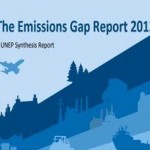
Montreal – At their working group meeting last month, the Parties to the Montreal Protocol on Substances that Deplete the Ozone Layer heard from the Protocol’s Halons Technical Options Committee (HTOC) and the International Civil Aviation Organization (ICAO) on yet another successful step in phasing out halons in fire extinguishers on aircraft.
Halons are among the most potent destroyers of the stratospheric ozone layer and are also potent greenhouse gases. Phasing out halons used in fire extinguishers on aircrafts has been a difficult challenge because of their effectiveness in fire fighting that in turn helps to increase the safety of passengers. However, in 2003, the Parties to the Montreal Protocol asked the Ozone Secretariat of the United Nations Environment Programme (UNEP) and its technical experts to begin to work with ICAO to look into the possibility of modifying the regulatory requirements that mandate the use of halons on new aircrafts without compromising the health and safety of airline passengers.
Thanks to the assistance of the Halon Technical Option Committee (HTOC), ICAO has amended two of its technical Annexes containing standards related to aircraft operations and airworthiness. Both Annex 6 – Operation of Aircraft – and Annex 8 – Airworthiness of Aircraft – have been amended to include a related environmental requirement.
“This was a landmark agreement that resulted from successful collaboration between two multilateral agreements, one for ozone protection and the other for international aviation. The Parties to the Montreal Protocol have been focusing their attention on enhancing collaboration and synergies with other international agreements and regimes. The Parties can be proud that the Montreal Protocol has again managed to contribute to both ozone and climate protection, this time through synergy in civil aviation sector,” said Marco Gonzalez, the Executive Secretary of the Ozone Secretariat.
“The agreement to phase out halons was another step forward by the Organization to further strengthen the ability to minimize the impact of air transport operations on the environment. The assistance of the HTOC and UNEP to reach this agreement was instrumental in realizing this achievement, and we look forward to continuing this important inter-agency cooperation to better serve the international community,” said ICAO’s Secretary General, Raymond Benjamin.
“The progress made by ICAO is important for the ozone layer protection. It is also significant as it demonstrates the commitment of ICAO to the environmental protection. For the first time, an operative annex to the Chicago Convention was changed to respond to an environmental concern. This is a win-win for the ozone layer and civil aviation. The United States congratulates the HTOC, ICAO and the Ozone Secretariat,” said Cindy Newberg, Chief of the Alternatives and Emissions Reduction Branch of the U.S. Environmental Protection Agency (U.S. EPA).
ICAO will continue to monitor the research and development of halon alternatives to ensure that the target dates can be met and will follow up on research into a viable halon alternative for cargo area fire extinguishing systems.
“We note that there is still much to be done to make sure that alternatives are identified and can be effectively used, to develop a viable path forward for cargo bays, and ensure that it does not become necessary to pursue use of the essential use provisions to support civil aviation on-going needs. We encourage the HTOC and Ozone Secretariat to continue to work with ICAO,” added Ms. Newberg.
“[We] would like to thank the HTOC in particular for its ongoing work with ICAO bodies in supporting the reductions in mandating the use of halons in new air frames. We would also like to thank the ICAO Secretariat for facilitating this excellent outcome and can agree that HTOC can continue its work as needed with ICAO bodies,” said Annie Gabriel from the Department of Sustainability, Environment, Water, Population and Communities of Australia.
ICAO is a specialized agency of the United Nations, was created in 1944 to promote the safe and orderly development of international civil aviation throughout the world. It sets standards and regulations necessary for aviation safety, security, efficiency and regularity, as well as for aviation environmental protection. The Organization serves as the forum for cooperation in all fields of civil aviation among its 190 Member States.
Source: UNEP.














